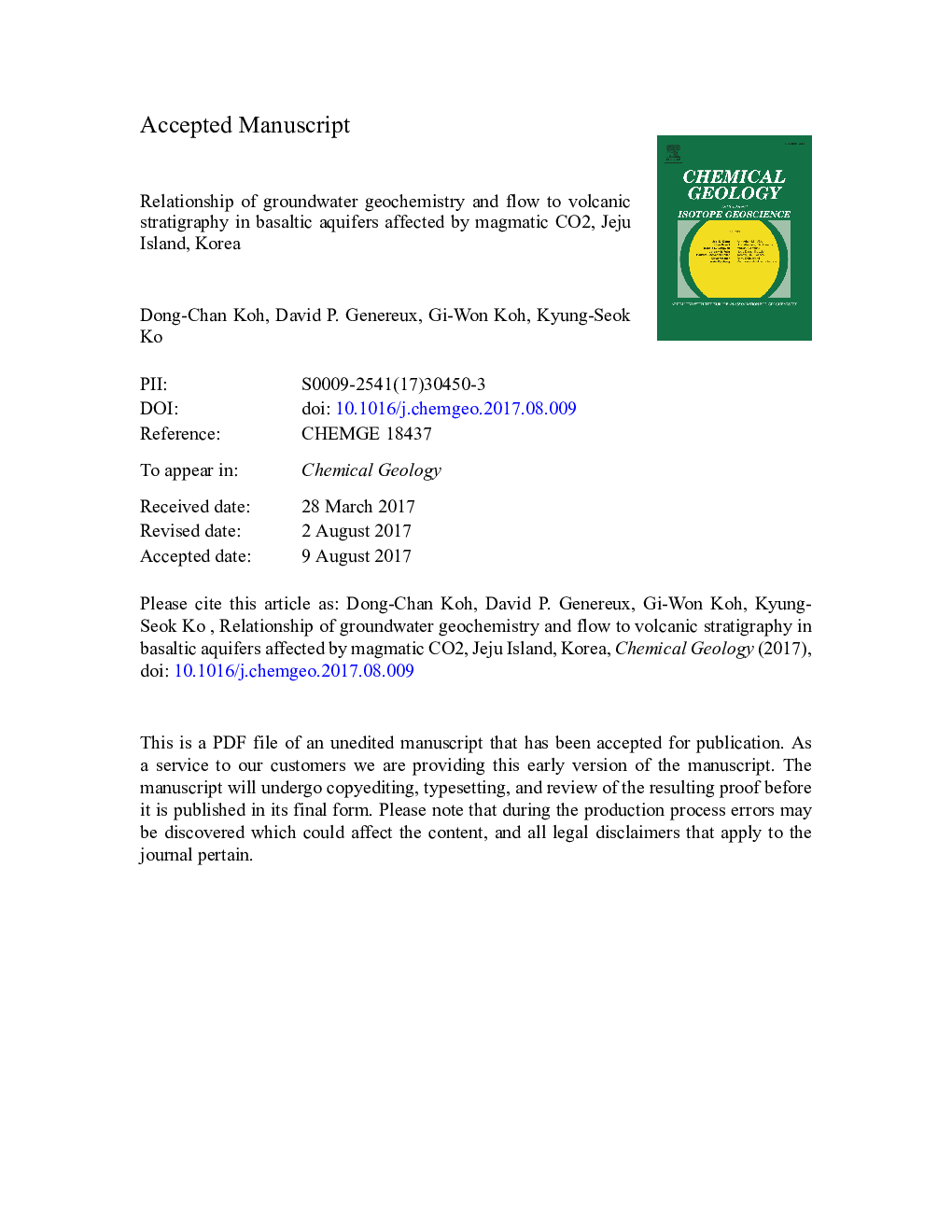| کد مقاله | کد نشریه | سال انتشار | مقاله انگلیسی | نسخه تمام متن |
|---|---|---|---|---|
| 5782687 | 1637507 | 2017 | 51 صفحه PDF | دانلود رایگان |
عنوان انگلیسی مقاله ISI
Relationship of groundwater geochemistry and flow to volcanic stratigraphy in basaltic aquifers affected by magmatic CO2, Jeju Island, Korea
دانلود مقاله + سفارش ترجمه
دانلود مقاله ISI انگلیسی
رایگان برای ایرانیان
کلمات کلیدی
موضوعات مرتبط
مهندسی و علوم پایه
علوم زمین و سیارات
ژئوشیمی و پترولوژی
پیش نمایش صفحه اول مقاله

چکیده انگلیسی
Groundwater from pristine volcanic rock aquifers on dormant Jeju Island, Korea, was investigated to identify sources and geochemical processes of dissolved inorganic carbon (DIC) and related solutes along with characteristics of groundwater flow using a multi-isotope approach. δ18O, δ2H, and 3H of groundwater indicated the water is of meteoric origin, and is mainly derived from recent recharge, except Na-rich mineral water which has a significant contribution of 3H-free old water. 87Sr/86Sr of dissolved Sr suggests that solutes in groundwater were mainly derived from old alkali basalt in the lower part of lava flows. δ13CCO2(g) calculated using δ13CDIC and measured hydrogeochemical parameters indicated that (1) biogenic soil CO2 is a dominant source of DIC in low mineralized water, (2) CO2-rich water had mostly mantle-derived magmatic CO2, and (3) mineral water contained both biogenic and magmatic CO2. δ13CCO2(g) in mineral water was affected by precipitation of calcite, which complicated the estimation of the contribution of CO2 sources to DIC. Concentrations of mobile elements were mainly controlled by the amount of magmatic CO2 and groundwater residence time. δ13CCO2(g) and 3H content were used to distinguish four types of groundwater with different spatial patterns of occurrence in relation to the volcanic stratigraphy of Jeju Island. Groundwater types I and II are low mineralized water with lower levels of DIC from biogenic CO2, composed of either recent recharge (< 40 years, type I) or older water with negligible 3H (> 60 years, type II). Type III is Mg-rich mineral water with significant recent recharge while type IV is Na-rich mineral water with older residence time. Types III and IV had somewhat elevated levels of DIC (up to 7.6 mM) with mixed signatures of magmatic and biogenic CO2, while CO2-rich water (a subset of type III) had DIC up to 100 mM with signatures of mantle-derived magmatic CO2. Groundwater in the eastern area of Jeju Island is mostly type I, which can be attributed to a lack of both low-permeability rocks and recent volcanic rocks in that area. Types III and IV were found in the western area where the latest volcanic rocks are distributed. In the southwestern area, type III is associated with permeable basaltic aquifers with a contribution of magmatic CO2 and type IV is from the younger lava flows dissected by older massive trachytic rocks and shallower hydrovolcanic tuffs, which led to the higher degree of mineralization. A conceptual model is proposed to integrate the chemical and isotopic constraints of groundwater with volcanic stratigraphy and suggest the processes that generated groundwater types with different residence times and chemical compositions. This study may contribute to understanding the processes of groundwater flow and mineralization in volcanic aquifers affected by deep-source CO2 and variable residence time of groundwater in both dormant and active volcanic areas.
ناشر
Database: Elsevier - ScienceDirect (ساینس دایرکت)
Journal: Chemical Geology - Volume 467, 20 September 2017, Pages 143-158
Journal: Chemical Geology - Volume 467, 20 September 2017, Pages 143-158
نویسندگان
Dong-Chan Koh, David P. Genereux, Gi-Won Koh, Kyung-Seok Ko,